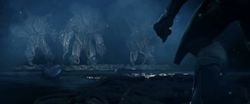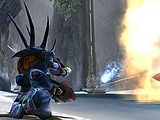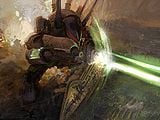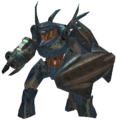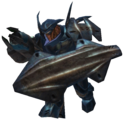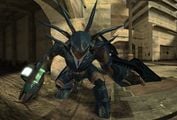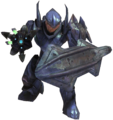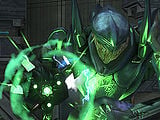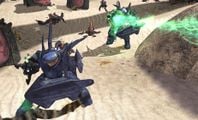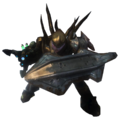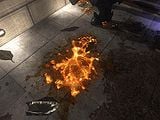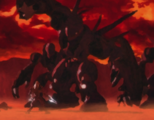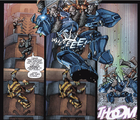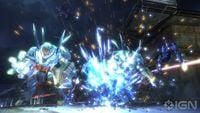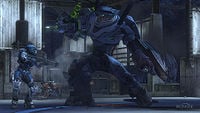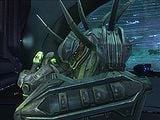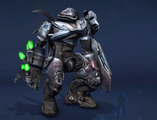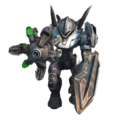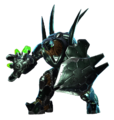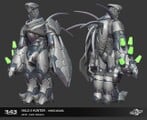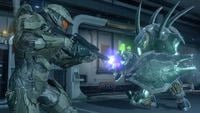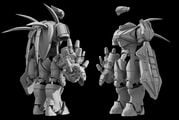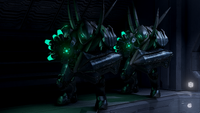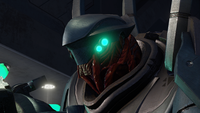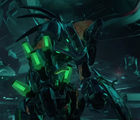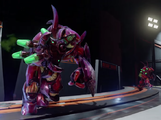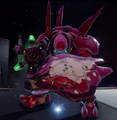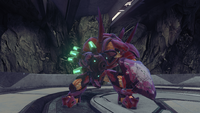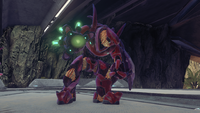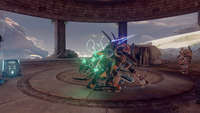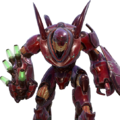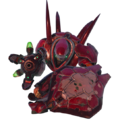Mgalekgolo: Difference between revisions
From Halopedia, the Halo wiki
Soul reaper (talk | contribs) No edit summary |
|||
| Line 44: | Line 44: | ||
[[File:Mgalekgolo back.jpg|250px|thumb|right|[[Lekgolo]] worms on a Mgalekgolo's exposed back.]] | [[File:Mgalekgolo back.jpg|250px|thumb|right|[[Lekgolo]] worms on a Mgalekgolo's exposed back.]] | ||
{{main|Lekgolo}} | {{main|Lekgolo}} | ||
A Mgalekgolo is not a single organism, but rather a collective of small, orange, eel-like creatures called [[Lekgolo]]. In order to form a Mgalekgolo, dozens of individual Lekgolo bond with one another both physically and neurologically to form a single "hive-minded" community.<ref>'''Halo: Contact Harvest''', ''page 267''</ref> The Mgalekgolo is the most common form seen in combat during the [[Human-Covenant War]], but is actually one of the | A Mgalekgolo is not a single organism, but rather a collective of small, orange, eel-like creatures called [[Lekgolo]]. In order to form a Mgalekgolo, dozens of individual Lekgolo bond with one another both physically and neurologically to form a single "hive-minded" community.<ref>'''Halo: Contact Harvest''', ''page 267''</ref> The Mgalekgolo is the most common form seen in combat during the [[Human-Covenant War]], but is actually one of the rarer and smaller forms in the Lekgolo society, used primarily in interaction with the Covenant hierarchy.<ref name="Bestiarum"/> Their primary combat tactic is an approximation of a hunter-killer formation, hence the name "Hunter".<ref name="wp lekgolo">[https://www.halowaypoint.com/en-us/universe/species/lekgolo-mgalekgolo-hunter '''Halo Waypoint''': ''Lekgolo/Mgalekgolo'']</ref> Because of their combined neural nets' sensitivity to their surroundings, Mgalekgolo can think and work as an effective combat unit without even using verbal communication. They can also locate their enemies even without directly "seeing" them, such as when they are facing the opposite direction. | ||
Mgalekgolo do not use vocal chords to speak, but instead vibrate their bodies to make a low rumble to produce speech. They are capable of mimicking the language of other species, forming words and sentences that are "felt" rather than heard. Their quiet nature among other races of the Covenant is probably a result of difficulty speaking with other Covenant races. The known names of some Mgalekgolo seem to imply that they use very simple vowels and only a few consonants. | Mgalekgolo do not use vocal chords to speak, but instead vibrate their bodies to make a low rumble to produce speech. They are capable of mimicking the language of other species, forming words and sentences that are "felt" rather than heard. Their quiet nature among other races of the Covenant is probably a result of difficulty speaking with other Covenant races. The known names of some Mgalekgolo seem to imply that they use very simple vowels and only a few consonants. | ||
Revision as of 21:17, February 17, 2016
| This article does not have enough inline citations and/or does not adhere to the proper citation format. You can help Halopedia by adding citations. |
- "They're all scary and angry and they like to smash things..."
- — Bungie
The Mgalekgolo[1] (Ophis congregatio, meaning "serpent union"),[2] is a gestalt of Lekgolo, which are small worm-like creatures that group together to exponentially increase their intelligence, strength, and maneuverability. Of the myriad Lekgolo collectives, the best known is the Mgalekgolo or Hunter, a bipedal form that is used for heavy assault. Ironically, the Mgalekgolo is among the least common Lekgolo configurations, but due to their formidable combat capabilities they are most commonly fielded by the Covenant.[1] While the term "Mgalekgolo" is formally limited to this particular type of Lekgolo gestalt with the other forms having different names,[1][3] it is sometimes applied to other Lekgolo colonies as well, such as that used to operate the Type-47 Scarab.[4]
History
After the formation of the Covenant, early experiments with the Luminaries reverse-engineered from the Forerunner Dreadnought in High Charity led the Covenant to the Lekgolo homeworld Te, which was located near Urs, the home system of the Sangheili. While the San'Shyuum and Sangheili hoped to find a treasure trove of Forerunner artifacts, they instead found hives of Lekgolo inside orbital rings surrounding the planet. The rings were in fact the destroyed remains of an ancient Forerunner installation in orbit. The relics had been the Lekgolo's food for millennia, and the orbital rings were actually composed of digested-and-destroyed Forerunner relics that some of the Lekgolo had been consuming.[5]
Enraged by the Lekgolo's "desecration" of Forerunner relics, the Covenant began a military campaign against the Lekgolo. After facing considerable difficulty eradicating the creatures,[1][5] a Sangheili Arbiter sent to study the Lekgolo for a full year on Rantu, one of Te's moons. It was there that the Arbiter witnessed the Lekgolo combine into Mgalekgolo to battle him, forming around a series of rocks to support their bipedal forms.[6] Recognizing the potential of the gestalts, the Arbiter returned to High Charity and suggested that the Lekgolo be inducted into the Covenant. This event later came to be known amongst the Covenant as the "Taming of the Lekgolo".
The Mgalekgolo gestalts, armed with thick armor plates and assault cannons, would come to serve the Covenant as shock troops. Numerous Mgalekgolo participated in the Human-Covenant War. During the Great Schism, most Mgalekgolo pairs sided with the Sangheili and the Swords of Sanghelios, though others remained with the Prophet of Truth and the main body of the Covenant.[7] There is no known reason for the split in loyalty.[1]
During the further conflicts in the wake of the Human-Covenant War many Mgalekgolo would fight on behalf of Jul 'Mdama's new Covenant order against humanity.[8] These Mgalekgolo participated in the battles of Requiem. Several would join Vata 'Gajat's mercenary group and partake in the Battle of Ealen IV.[9]
Description
Anatomy and physiology
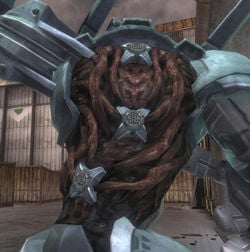
- Main article: Lekgolo
A Mgalekgolo is not a single organism, but rather a collective of small, orange, eel-like creatures called Lekgolo. In order to form a Mgalekgolo, dozens of individual Lekgolo bond with one another both physically and neurologically to form a single "hive-minded" community.[10] The Mgalekgolo is the most common form seen in combat during the Human-Covenant War, but is actually one of the rarer and smaller forms in the Lekgolo society, used primarily in interaction with the Covenant hierarchy.[1] Their primary combat tactic is an approximation of a hunter-killer formation, hence the name "Hunter".[3] Because of their combined neural nets' sensitivity to their surroundings, Mgalekgolo can think and work as an effective combat unit without even using verbal communication. They can also locate their enemies even without directly "seeing" them, such as when they are facing the opposite direction.
Mgalekgolo do not use vocal chords to speak, but instead vibrate their bodies to make a low rumble to produce speech. They are capable of mimicking the language of other species, forming words and sentences that are "felt" rather than heard. Their quiet nature among other races of the Covenant is probably a result of difficulty speaking with other Covenant races. The known names of some Mgalekgolo seem to imply that they use very simple vowels and only a few consonants.
Mgalekgolo usually stand between twelve to thirteen feet tall, but during combat they hunch themselves over to protect their vulnerable neck and midsection, reducing their height to roughly eight feet. They fight using assault cannons integrated directly into their armor, and they carry an enormous shield made of an alloy derived from the same material that forms Covenant warship hulls.[3] This shield protects them from almost every form of plasma-based or ballistic weaponry available to Covenant and human infantry alike, and is a powerful melee tool capable of crushing anything in its path and allowing the Mgalekgolo to sweep away most enemies in close combat.
The assault cannon the Mgalekgolo wields operates in two modes; one firing a single explosive capsule of incendiary fluid,[11] the other spraying the fluid out like a beam.[12][13]
Bond brothers
When a single Mgalekgolo becomes too big, the colony will divide in half to create two independent Lekgolo colonies. These colonies will share an extremely close and mysterious bond, referred to only as being "bond brothers", or "mates".[14] Mgalekgolo that have split into "bond brothers" are recognized by spiked appendages that rise from their shoulders, which means that they are bonded to another Mgalekgolo.[5] Bonded Mgalekgolo colonies are dropped into battle together by the Covenant, as the Spartans learned: where you find a Mgalekgolo, there is always another close by. If one of the bonded colonies is killed, the other will go into a frenzied state, much like the berserk state of a Jiralhanae, or the suicidal charge of a desperate Unggoy. If left alone for a long period of time, however, they will adopt a "tactical split personality" of shooting followed by melee attacks.
Naming
Mgalekgolo have three names: a personal name, a bond name, and a line name. The personal name is given at their "birth". The line name represents the genetic heritage, being the name of the most successful Mgalekgolo of its ancestors.[citation needed] If one reaches a certain level of status, its offspring will have its personal name as their line name.[citation needed] The bond name, or their middle name, is taken between bonded pairs. Examples of some Mgalekgolo names include Igido Nosa Hurru and Ogada Nosa Fasu.[15]
Ranking system
Unlike most Covenant forces, Mgalekgolo seem to possess no visible rank. As they are deployed more like equipment or weapons platforms rather than conventional troops, rank may simply not apply for them.
However, they can be deployed independently of other Covenant troops, which may indicate that a level of independence and responsibility may be granted, thus meaning that they may have a high enough rank to be trusted by themselves. During the Battle of Sigma Octanus IV, Mgalekgolo are seen guarding the crystal in Côte d'Azur, which is retrieved by Blue Team. One of these Mgalekgolo killed a Kig-Yar by stepping on it,[16] demonstrating the Lekgolo colonies' characteristic disregard for the lives of other species, whom they generally view as annoyances rather than allies.[3] During the Battle of Onyx, some Mgalekgolo apparently had command of lower-ranking Sangheili, even killing one of them for failing to follow orders, signifying they may have a higher military rank in the Covenant military than previously indicated.[17]
During the Battle of Mombasa, Mgalekgolo appeared in two different forms in two different colors: the normal blue-armored Mgalekgolo that are armed with an assault cannon that fires a continuous stream of radioactive incendiary gel, and a gold-armored Mgalekgolo armed with an assault cannon that fires a single bolt of radioactive incendiary gel.[18]
Trivia

|
See our gameplay information related to Mgalekgolo on its gameplay page. |

|
Browse more images in this article's gallery page. |
Production notes
- Halo: The Flood, mentions that Mgalekgolo have skin and a jutting spine. This is incorrect, as they were later revealed to be a compound of small worm-like creatures. However, this does not preclude the possibility that the worms may form a skin-like membrane on the outside of their colony for protection against more casual damage, and in Halo 3 a metal column can be seen after the back armor plating has been detached, perhaps forming an artificial "spine" for vertical support. Strangely, the reference to Mgalekgolo having spines was kept in the 2010 re-release of the novel.[19]
- At first, Mgalekgolo were meant to comprise the whole of Heretic forces on the Threshold gas mine.[20]
- The Mgalekgolo was inspired by the Pfhor Hunter from the Marathon series, as well as by the Drinniol, or Hulk, from the original Marathon. However, the Pfhor Hunter is actually a class of power armored soldier with a shoulder-mounted cannon rather than an arm-mounted cannon. The Drinniol also inspired the creation of the Drinol, Covenant species that was designed for Halo: Combat Evolved but was cut during development.
- No Mgalekgolo are ever seen supporting the Master Chief during the events of Halo 3. This is because in the making of Halo 3, Bungie did not want to confuse players by having them with both allies and enemies.
- Despite appearing on the cover of Halo: Spartan Assault none actually appear in game.
- In the Halo Legends episode The Duel, the Mgalekgolo are shown to be at least 50 feet tall. This was explained by Frank O'Connor saying that a Hunter's appearance changes due to the gravity and environment.
Gameplay
- When combating Mgalekgolo, a player can 'leapfrog' the charging melee attack, either jumping above or to the side of the Mgalekgolo. This exposes the rear armor to a quick shotgun blast or grenade stick, often resulting in death on lower difficulties. Although this tactic does not work as well on Halo 3: ODST, simply circling around behind the Mglekgolo at the right time works the same way.
- In Halo 3, it is possible to splatter a Mgalekgolo with a M274 Mongoose.
- In Halo: Combat Evolved Mgalekgolo are not harmed by fuel rod guns. This may be because you're not supposed to have fuel rod guns in campaign, or it may be a precaution meant to prevent Mgalekgolo from injuring each other when fighting.
- Mgalekgolo have ranks in the actor variant tags. One variant is called 'Hunter' and another called 'Hunter major'.
- In Halo: Combat Evolved, a single shot from a pistol or sniper rifle to any non armored section will kill a Mgalekgolo; this is likely because the Mgalekgolo's exposed flesh was considered to be its "head."
- In Halo 2, a Mgalekgolo's mass is enough to kill other characters if they push them against a surface. This can sometimes be seen in The Great Journey, where friendly Mgalekgolo may accidentally crush Sangheili against walls.
- In Halo 2, it is impossible to kill or even damage Mgalekgolo with melee attacks.
- In Halo Wars, a Mgalekgolo's shield can deflect projectiles that would almost always kill them in previous games, like Wraith Mortars and shots from the M808B Scorpion's main cannon.
- In Halo: Reach, Mgalekgolo have received a huge graphical overhaul. They are much more textured, are larger, have Forerunner symbols and emblems on their armor and appear to have some kind of eyes on their helmets.
- Mgalekgolo are also much tougher in Reach. They are capable of surviving multiple explosive hits and even repeated plasma grenade sticks. Their back armor is much more durable, making their weak point harder to expose. They will also raise their shield vertically when being attacked from the front, covering both their neck and mid-section to protect themselves from incoming fire and are less likely to turn around and expose their back to the player.
- In Halo: Reach, a near-miss from a Mgalekgolo's melee will cause the player's screen to violently shake.
- Although the Mgalekgolo present in Halo: Anniversary use the Halo: Reach skin, they are almost half the size of their Halo: Reach counterparts due to the much smaller skeleton frame used in the original game. Their abdomens also appear to be armored, though this armor doesn't do anything and they're just as vulnerable as they were in the original game.
- In Halo 4, Mgalekgolo perform melee attacks much faster than their predecessors, making it harder to dodge them. Like in Halo Reach, a near-miss from a melee will cause the player's screen to violently shake.
- In Halo 2: Anniversary, Mgalekgolo received a new skin that also incorporates abdominal armor, though this armor is also purely cosmetic and offers no protection whatsoever.
- In Halo 5: Guardians, Mgalekgolo are far more lethal than their predecessors. Their melee strikes are now nearly impossible to dodge. They also utilize both firing modes of their assault cannons. They also appear to be far more durable than their predecessors. In addition, when one is killed, the remaining Mgalekgolo will start emitting green electrical sparks and will fire it assault cannon's close range attack twice in each volley.
Miscellaneous
- Like most other races of the Covenant, Mgalekgolo's blood differs from that of humans. Mgalekgolo blood is bright, fluorescent orange and appears to have a very thick, slimy texture. It has also been noted that their blood smells strongly of burnt plastic, hinting that the make-up of their bodily fluids is drastically different from that of a human.
Gallery
Early concept art of a Mgalekgolo for Halo: Combat Evolved.
Final in-game view of the Mgalekgolo in Halo: Combat Evolved, with gun raised.
Finalized concept art of a Mgalekgolo for Halo 2.
An in-game view of the blue-armored Mgalekgolo in Halo 3.
- Fuel Rod Beam Cannon in Action.jpg
A Mgalekgolo firing its assault cannon.
- Cov Hunter.jpg
Concept art of a Mgalekgolo for Halo Wars.
- Covenant hunter.gif
A pair of Mgalekgolo from Halo Wars.
An in-game view of the gold-armored Mgalekgolo in Halo 3: ODST.
- Gold Hunter.png
A pair of gold Mgalekgolo in Halo 3: ODST.
A larger form of Mgalekgolo in the Halo Legends episode, The Duel.
A Mgalekgolo carrying three Unggoy Minors during the Battle of Line Installation 1-4 in Halo: Blood Line.
A Mgalekgolo in the Halo: Reach Beta.
An in-game view of the Mgalekgolo in Halo: Reach final build.
A Mgalekgolo on Corvette.
Mgalekgolo in Halo: Combat Evolved Anniversary.
A Mgalekgolo in Halo 4: Forward Unto Dawn.
A Mgalekgolo in Halo 4
John-117 battling a Mgalekgolo in during the Raid on Ivanoff Station.
Sarah Palmer fighting a Mgalekgolo in a War Games simulation in Halo: Escalation.
3D render of the Mgalekgolo's body armor in Halo 2: Anniversary.
Pre-Covenant Mgalekgolo in Halo 2: Anniversary's terminals.
A Mgalekgolo being formed aboard the UNSC Argent Moon in Halo 5: Guardians.
A Serpent Mgalekgolo on Escape from ARC.
- H5G-ElderHunter.jpg
A hologram of an Elder Mgalekgolo.
An Elder Mgalekgolo on Raid on Apex 7.
List of appearances
Sources
- ^ a b c d e f Bestiarum
- ^ HBO Forums: Bestiaium Latin names translated
- ^ a b c d Halo Waypoint: Lekgolo/Mgalekgolo
- ^ Halo: The Essential Visual Guide, page 163
- ^ a b c Halo: Contact Harvest, pages 269-271
- ^ Halo 2: Anniversary, Terminal 8
- ^ Halo 2, campaign level Uprising
- ^ Halo 4
- ^ Halo: Escalation, Issue 2'
- ^ Halo: Contact Harvest, page 267
- ^ Halo: Combat Evolved
- ^ Halo 2
- ^ Halo 3
- ^ Halo: The Flood, "Chapter ??", page ??"
- ^ Halo: The Flood, page 163
- ^ Halo: The Fall of Reach, page 222
- ^ Halo: Ghosts of Onyx, page 358
- ^ Halo 3: ODST
- ^ Halo: The Flood (2010), page 181
- ^ Halo 3 Essentials: Disk ??
